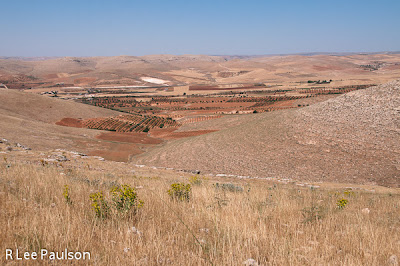Turkey 26: Gobekli Tepe Conclusion
So far, we've seen only a portion of the the site that is Gobekli Tepe. But, Gobekeli Tepe is only 5 percent excavated. Several fenced off areas can be seen where partial excavations along precise grids have begun.
One can see from even these partial excavations that much is yet to be learned from this site.
Klaus Schmidt says that he could easily excavate here for the next 50 years.
In 2010, Global Heritage Fund announced that it will undertake a multi-year conservation program to preserve Gobekli Tepe. Gobekli Tepe is already a Turkish heritage site and has the protection of the Army.
As mentioned before, Gobekli Tepe sits on a hilltop overlooking a picturesque valley.
One can only wonder what this valley has seen in the way of human habitation since humans first began settling here.
We visited a museum in Urfa where some of the stone figures found at Gobekli Tepe have been taken.
All we can do is guess at their meaning. There is no way of knowing for sure what the creators intended.
Indeed, I believe that even when Gobekli Tepe has been completely excavated, there will still be far more questions than answers.
However, in spite of all our unanswered questions, the bottom line is that Gobekli Tepe has forced us to seriously rethink our vision of how mankind evolved.
It has forced us to rethink our vision because Gobekli Tepe has made at least one fact abundantly clear. And that is the so-called "primitive" hunter/gatherers back around 9,000 BCE were far, far more sophisticated and advanced than anyone had previously thought.
As one of the archeologists quoted in a National Geographic article said, "Discovering that hunter-gatherers had constructed Gobekli Tepe was like finding that someone had built a 747 in a basement with an X-Acto knife."
One can see from even these partial excavations that much is yet to be learned from this site.
Klaus Schmidt says that he could easily excavate here for the next 50 years.
In 2010, Global Heritage Fund announced that it will undertake a multi-year conservation program to preserve Gobekli Tepe. Gobekli Tepe is already a Turkish heritage site and has the protection of the Army.
As mentioned before, Gobekli Tepe sits on a hilltop overlooking a picturesque valley.
One can only wonder what this valley has seen in the way of human habitation since humans first began settling here.
We visited a museum in Urfa where some of the stone figures found at Gobekli Tepe have been taken.
All we can do is guess at their meaning. There is no way of knowing for sure what the creators intended.
Indeed, I believe that even when Gobekli Tepe has been completely excavated, there will still be far more questions than answers.
However, in spite of all our unanswered questions, the bottom line is that Gobekli Tepe has forced us to seriously rethink our vision of how mankind evolved.
It has forced us to rethink our vision because Gobekli Tepe has made at least one fact abundantly clear. And that is the so-called "primitive" hunter/gatherers back around 9,000 BCE were far, far more sophisticated and advanced than anyone had previously thought.
As one of the archeologists quoted in a National Geographic article said, "Discovering that hunter-gatherers had constructed Gobekli Tepe was like finding that someone had built a 747 in a basement with an X-Acto knife."













0 Comments:
Post a Comment
Subscribe to Post Comments [Atom]
<< Home